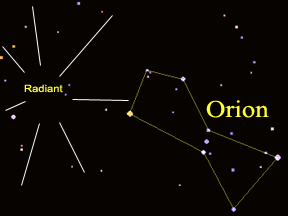
Image courtesy of NASA.
Lyrid Meteor Shower
The Lyrid meteor shower is one of several major meteor showers that occur every year. A particular meteor shower happens around the same time each year as Earth's orbit carries it through the same region in space. The Lyrids typically "peak" (are at their greatest level of activity) around April 22nd. The Lyrid shower's name is derived from the fact that its meteors appear to fan out from a point in sky, called the shower's "radiant", which lies within the constellation Lyra.
As is the case with most meteor showers, it will be possible to see Lyrid meteors for several days before and after the peak on the 22nd. At this shower's peak observers can typically see between 10 and 20 "shooting stars" per hour under dark skies (away from city lights). 2009 may be a good year for viewing the Lyrids because the Moon will be at its waning crescent phase around the peak of the meteor shower. That means there won't be much moonlight (which makes it hard to see meteors).
Sometimes, very rarely, the peak of the Lyrids brings 100 or more meteors per hour. In 1982, observers counted over 90 meteors per hour. In 1803, a journalist watching the Lyrids "counted 167 meteors in about 15 minutes"! The Lyrids of 1922 and 1945 also had peak rates around 100+. It was probably just such a "Lyrid storm" that caught the eye of Chinese astronomers in 687 BC, who wrote of "stars that fell like rain." Humans have known of the Lyrid meteors for more than 2,600 years... longer than any other shower!
The Lyrids are actually bits of dust that have been shed over the centuries by a comet (comet Thatcher). The dust, which spews forth from the comet's nucleus each time it passes near the Sun, gradually spreads out over the entire orbit of the comet. If Earth's orbit happens to cross the comet's orbit, the swarm of debris scattered along the comet's orbit is visible to us as a meteor shower. Since the Earth crosses the comet's orbit at the same time each year, each meteor shower is predictably visible at the same time of year, year after year.













